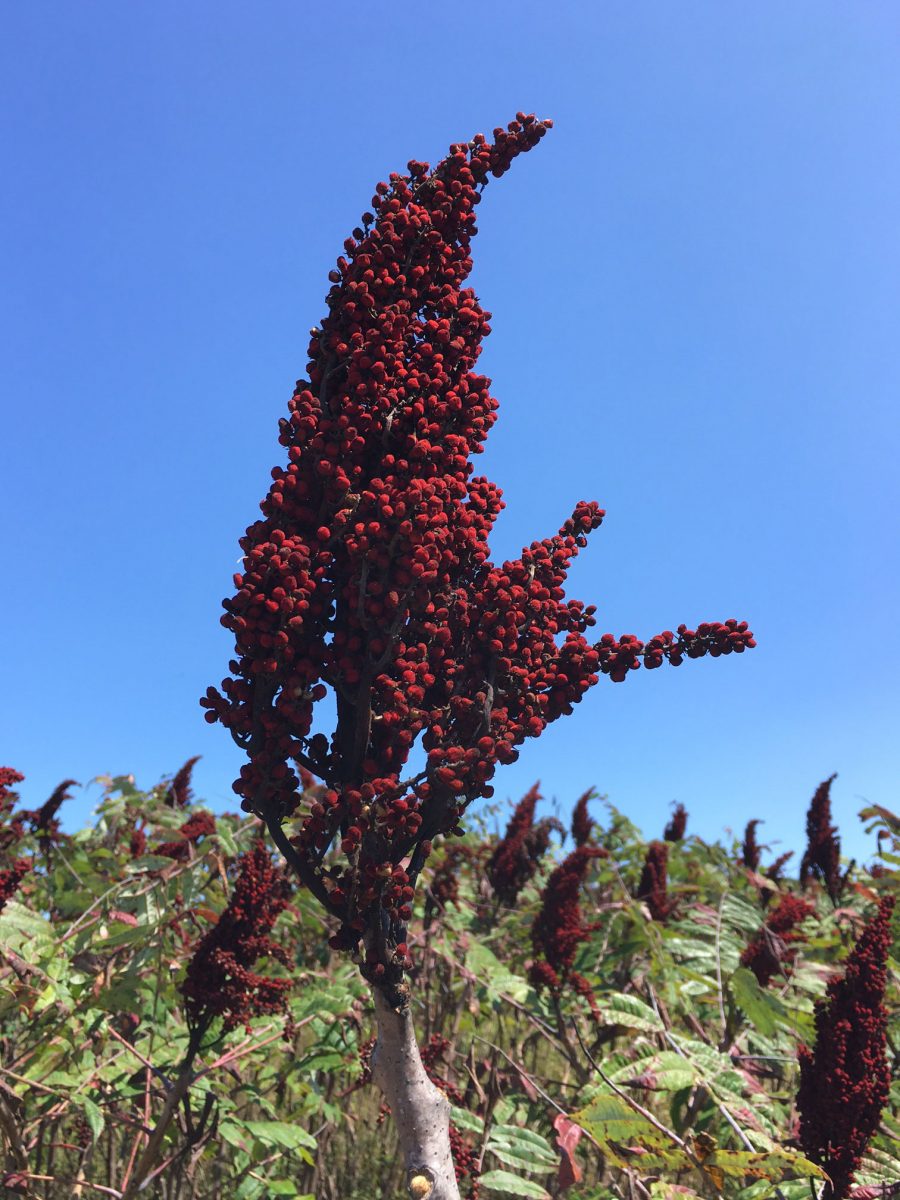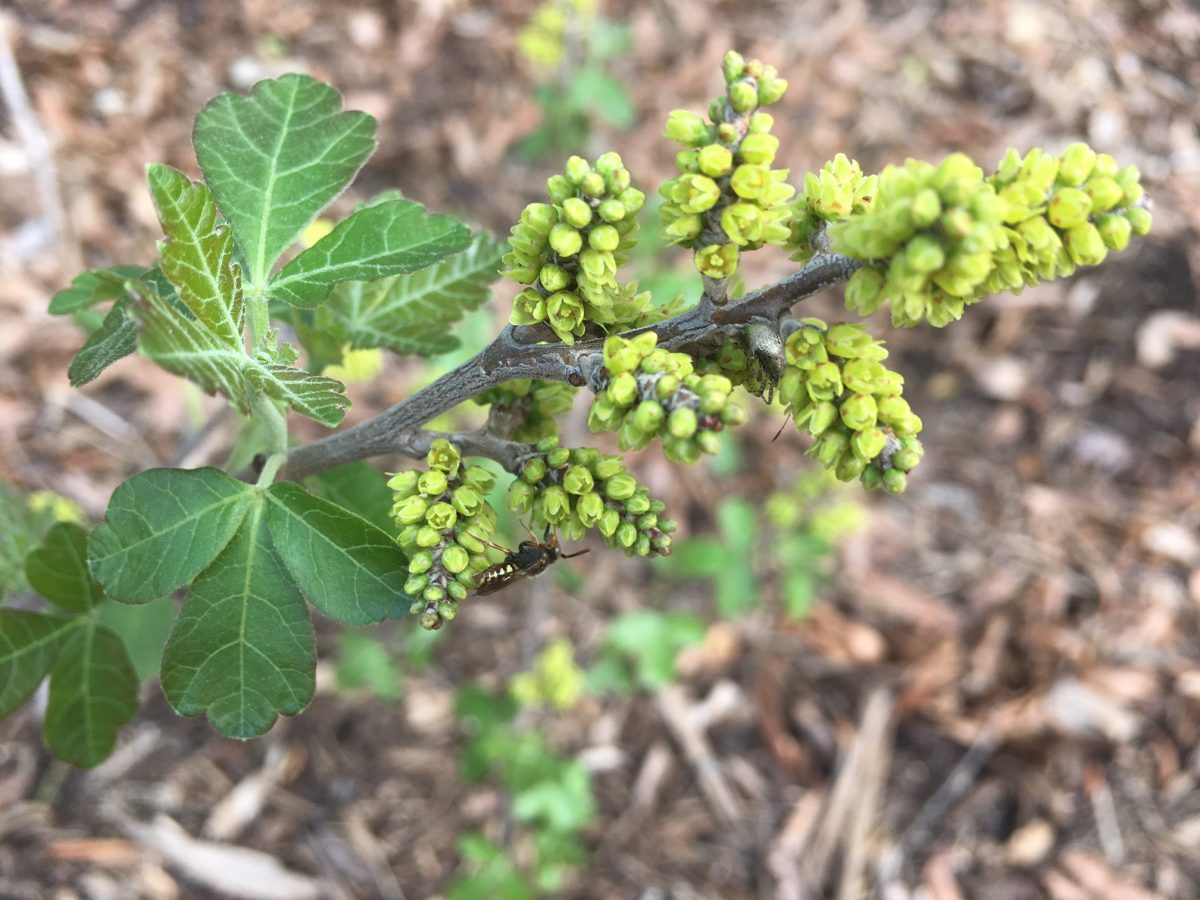Sumac shows its glories in autumn

October has been as sultry as summer, but there’s finally the promise of weather that calls for sweatshirts and jackets. Deciduous trees and shrubs across the Piedmont have already started to don their autumn finery. Dogwoods are burnished a deep maroon, and poplars are shedding golden leaves. This time of year, few species are as glorious as the sumacs.
In addition to their fiery foliage, female plants boast large clusters of showy red fruits. These account for their appeal to wildlife. Songbirds, game birds and squirrels eat the seeds, and the flowers are a nectar source for native pollinators. Rabbits and deer browse the leaves.
 Seed head of a smooth sumac (Rhus glabra). Photo: Ruth Ann Grissom
Seed head of a smooth sumac (Rhus glabra). Photo: Ruth Ann Grissom
Smooth sumac (Rhus glabra) and winged sumac (Rhus copallina) are common along roadsides in the Uwharries. Both species tolerate poor, disturbed soil and thrive on dry, sunny sites. They also flourish in recent clear-cuts and abandoned pastures and fields. They spread by rhizomes to form large thickets, and they often reach heights of 10-30 feet. Their leaves are large, generally composed of at least a dozen leaflets. Winged sumac’s distinguishing characteristic is the stem connecting the leaflets – technically known as a rachis – which is wide and flat, augmented by flaps of leaf material.
At first glance, both species can easily be confused with the dreaded tree of heaven (Ailanthus altissima). I’ve been fooled at a distance, and a knowledgeable friend once mistakenly sprayed a clump of sumac with herbicide. For help making a correct identification, I turned to an excellent guide from the New York Botanical Garden.) First, look closely at the leaflets. Sumacs have serrated edges, while those on the tree of heaven are smooth except for a bump near the base. Then snap a leaf from the stem. Sumacs have milky sap. The tree of heaven’s sap is clear with a strong, unpleasant odor.
Fragrant sumac (Rhus aromatica) is far less common. In the Uwharries, it can be found along forest margins. It generally grows no taller than 3 to 6 feet. The trilobed leaves are coarsely toothed and extremely fragrant. To my nose, they are citrusy in spring but become increasingly aromatic in fall.
 Fragrant sumac (Rhus aromatica) has a ‘Gro Low’ cultivar that smells like citrus in spring. Photo: Ruth Ann Grissom
Fragrant sumac (Rhus aromatica) has a ‘Gro Low’ cultivar that smells like citrus in spring. Photo: Ruth Ann Grissom
Some outdoor enthusiasts have concerns about encountering poison sumac (Toxicodendron vernix) in the Uwharries. While the species has been documented at scattered locations across the state, including Anson and Richmond counties, this shrub or small tree is typically restricted to swampy habitats. The leaves are oval with wavy edges, and taper to a point. Like other “poison” species, such as Atlantic poison oak (Toxicodendron pubescens) and Eastern poison ivy (Toxicodendron radicans), it was once assigned to the genus Rhus.
Given their beauty and benefit to wildlife, sumacs would seem an obvious addition to the native garden, but most people consider them too aggressive for use anywhere other than wild, natural settings. That said, intrepid English gardeners have long embraced sumacs. They simply remove the suckers that pop up each spring.
Fortunately, plantsmen have developed cultivars that mind their manners, even in formal shrub borders. ‘Gro Low’ is a fragrant sumac that remains 2 to 3 feet tall with a spread of 6 to 8 feet. Its clusters of bright yellow flowers are a welcome sight on a gray day in late March, both for humans and a slew of early pollinators. The male I planted in my back yard sports tiny, persistent catkins. Females produce red drupes, but they seem hard to come by in the nursery trade.
Staghorn sumac (Rhus typhina) is a more northern species, occurring only in our mountains. The common name refers to the fuzzy brown stems that extend its aesthetic appeal into winter. I haven’t been able to track down the two named cultivars, ‘Dissecta’ and ‘Laciniata,’ but I couldn’t resist its charms, so I planted the straight species at the edge of our yard in the Uwharries. So far, Dad’s lawnmower has kept the colonies in check.
Staghorn sumac is also the progenitor of the visually stunning cultivar ‘Tiger Eyes,’ which stays 3 to 6 feet tall with a similar spread. The foliage emerges chartreuse and turns to bright gold. The rachis is pinkish purple. My sister has one in her tropical garden, and Mama has them at the feet of dark pink crape myrtles. Perfect! This spring, I lifted a few sprouts and added them in my burgeoning English shrub border. I love how they echo the colors of another exciting native cultivar, Illicium parviflorum ‘Florida Sunshine.’